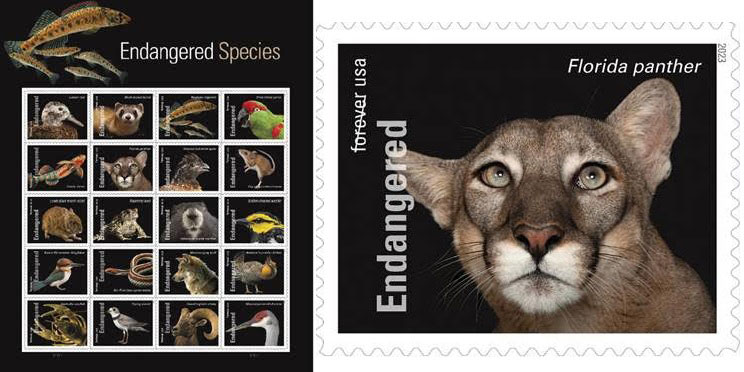America’s natural bounty includes an astounding variety of unique and priceless wildlife. Under the Endangered Species Act (ESA), which marks its 50th anniversary in 2023, more than 1,300 imperiled plant and animal species are safeguarded to increase their chances of survival. The Florida panther is among the endangered species.
The pane of USPS stamps, which may be purchased at your local Post Office, presents a photographic portfolio of 20 endangered animal species, which are found within the 50 states and American territories and possessions or living near U.S. borders:
 Top Row: Laysan teal (photographed at Palm Beach Zoo in Palm Beach, FL), black-footed ferret, Roanoke logperch, thick-billed parrot
Top Row: Laysan teal (photographed at Palm Beach Zoo in Palm Beach, FL), black-footed ferret, Roanoke logperch, thick-billed parrot
Second Row from top: Candy darter, Florida panther (photographed at Lowry Park Zoo in Tampa, FL), masked bobwhite quail, Key Largo cotton mouse
Third Row from top: Lower Keys marsh rabbit (photographed wild in Key West, FL), Wyoming toad, Vancouver Island marmot, golden-cheeked warbler
Fourth Row from top: Guam Micronesian kingfisher, San Francisco garter snake, Mexican gray wolf, Attwater’s prairie chicken
Bottom Row: Nashville crayfish, piping plover, desert bighorn sheep, Mississippi sandhill crane
The colorful and charismatic endangered creatures presented on the stamps are selected from among more than 13,000 species featured in Joel Sartore’s National Geographic Photo Ark project which aims to document every species living in the world’s zoos, aquariums, and wildlife sanctuaries; inspire action through education; and help protect wildlife by supporting on-the-ground conservation efforts.
The First-Day-Of-Issue stamp dedication ceremony took place in Wall, South Dakota, where participants included U.S. Postal Service Vice President, Government Relations and Public Policy Peter Pastre, U.S. Fish and Wildlife Service Director Martha Williams, and National Geographic Explorer and Photographer Joel Sartore.
On Dec. 27, 1973, President Richard Nixon signed the ESA into law. In the 50 years since, other nations worldwide have emulated the pioneering U.S. initiative. The ESA provides a framework to conserve and protect endangered and threatened species and their habitats both domestically and abroad.
Under the ESA, more than 1,670 U.S. species and 698 foreign species are safeguarded to increase their chances of survival. Scientists estimate that hundreds of species have been rescued from the brink of extinction in the United States since the ESA began. A species found to need protection is listed under the ESA as either threatened or endangered, the latter defined as “in danger of extinction throughout all or a significant portion of its range.”


